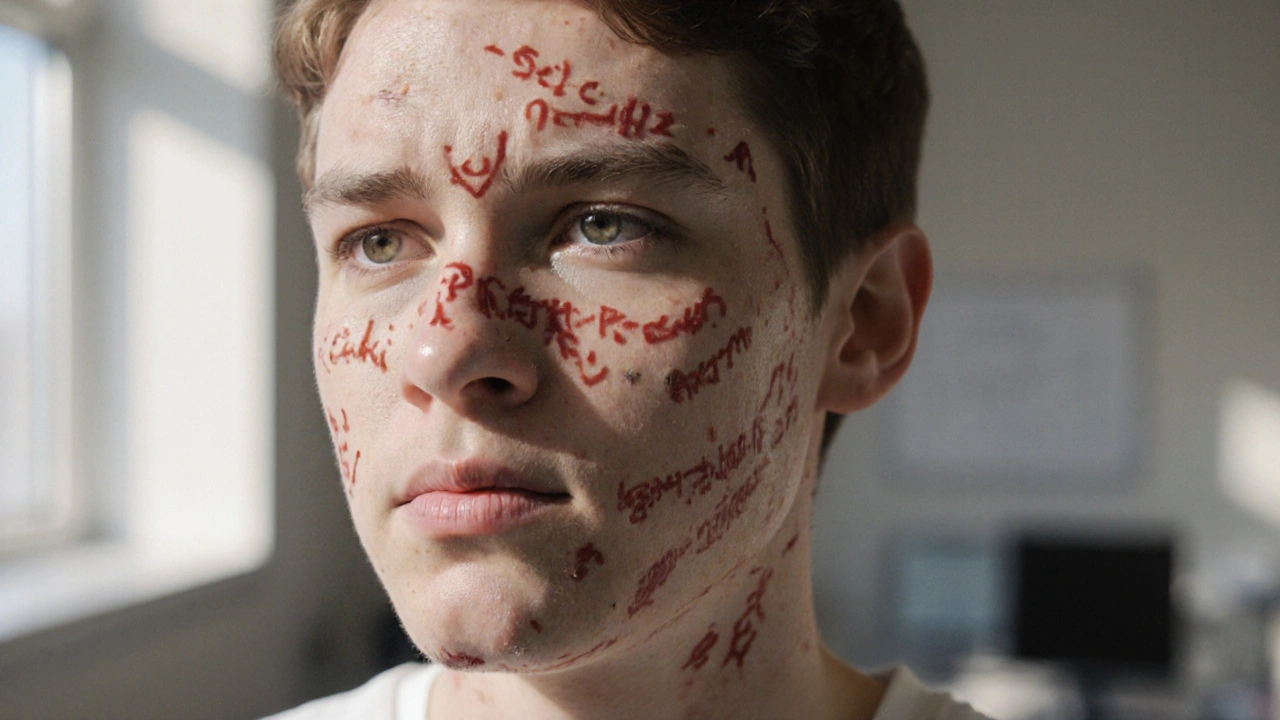
Acne Treatment Decision Guide
How severe is your acne?
Are you pregnant or could you become pregnant?
Do you have concerns about specific side effects?
Please select your answers to get a recommendation.
Here's what each treatment offers:
- Accufine (Isotretinoin): For severe acne, 70-90% clearance
- Doxycycline: Anti-inflammatory, 30-50% improvement
- Adapalene: Over-the-counter retinoid, mild to moderate acne
- Spironolactone: Hormonal acne in women, 25-45% improvement
- Trifarotene: Newer oral retinoid, 60-80% clearance
If you’ve tried countless creams and pills and still battle stubborn acne, you’ve probably heard the name Accufine. It’s one of the few oral retinoids that can turn severe breakouts around, but it isn’t the only game‑changer on the table. This guide breaks down what Accufine actually is, how it stacks up against the most popular alternatives, and which factors should guide your decision.
What is Accufine (Isotretinoin)?
Accufine is a brand name for Isotretinoin, a synthetic form of vitamin A that targets the root causes of severe acne.
Isotretinoin works by shrinking oil glands, reducing sebum production, normalising skin cell turnover and dampening inflammation. Because it attacks acne from several angles, dermatologists reserve it for nodular or cystic acne that hasn’t responded to topical or oral antibiotics.
How Accufine works and what to expect
The typical Accufine regimen starts at 0.5mg per kilogram of body weight per day, gradually increasing to 1mg/kg as tolerated. Treatment usually lasts 4-6months, with most patients seeing a 70‑90% reduction in inflammatory lesions by the end.
Side effects are well‑documented. The most common are dry skin, chapped lips and mild eye irritation. A small percentage experience elevated liver enzymes or a rise in blood triglycerides, so regular blood work is mandatory. The biggest caution is teratogenicity - women of childbearing age must use two forms of reliable contraception during treatment and for a month after stopping.
Because Accufine is a high‑potency retinoid, it’s not a “quick fix.” Patients often need supportive skin‑care (gentle cleansers, moisturisers) and may be prescribed topical agents to manage initial flare‑ups.
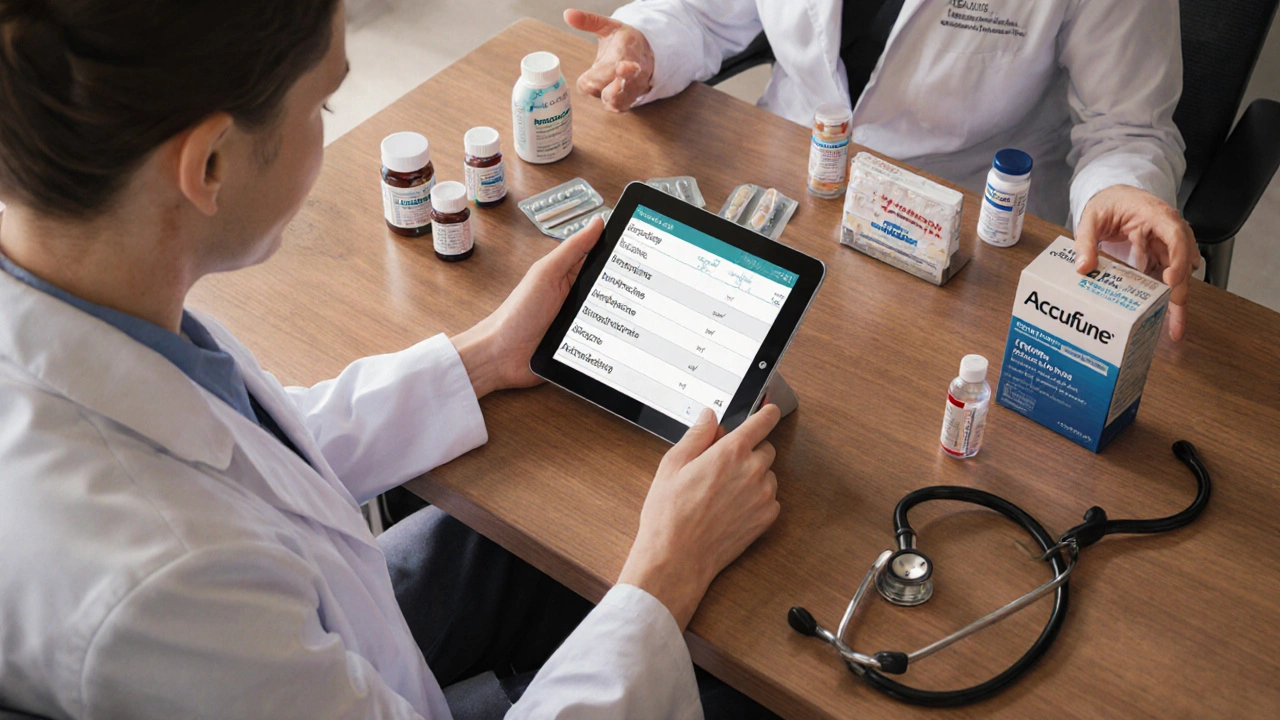
Main alternatives for moderate to severe acne
Below are the most frequently prescribed options beside isotretinoin. Each has a distinct mechanism and a different suitability profile.
- Doxycycline - a broad‑spectrum tetracycline antibiotic that reduces bacteria and inflammation. Usually taken 100mg twice daily for 12-16weeks.
- Minocycline - another tetracycline, often preferred for patients who develop stomach irritation with doxycycline. Dose ranges from 50‑100mg once or twice daily.
- Adapalene - a third‑generation topical retinoid, sold over the counter in 0.1% gels. It normalises follicular keratinisation and is less irritating than earlier retinoids.
- Tretinoin - a prescription‑only topical retinoid (0.025‑0.1% creams). It’s more potent than adapalene but can cause noticeable redness and peeling.
- Oral contraceptives - combined estrogen‑progestin pills that lower androgen levels, decreasing oil production. Brands vary, but a typical dose follows a 21‑day active/7‑day placebo cycle.
- Spironolactone - an anti‑androgen often used off‑label for adult women with hormonal acne. Starting dose is 50mg daily, titrating up to 200mg.
- Trifarotene - a newer oral retinoid approved for both acne and psoriasis. Its selectivity for retinoic acid receptor‑γ may reduce some side effects seen with isotretinoin.
Side‑effect profile comparison
Understanding what each treatment can do to your body is key. Below is a quick rundown of the most frequent adverse events.
- Accufine (Isotretinoin): Dry skin, chelitis, photosensitivity, possible liver enzyme elevation, teratogenic risk.
- Doxycycline / Minocycline: Sun sensitivity, gastrointestinal upset, rare yeast infections, possible pigment changes with long use.
- Adapalene: Mild irritation, dryness, occasional burning.
- Tretinoin: Pronounced redness, peeling, and a short‑term worsening of acne (purging).
- Oral contraceptives: Nausea, breast tenderness, slight increase in blood clot risk, mood changes.
- Spironolactone: Dizziness, menstrual irregularities, potassium elevation (rare).
- Trifarotene: Similar to isotretinoin but reports suggest less severe mucosal dryness.
Most side effects are manageable with dose adjustments or adjunctive skin‑care. However, the teratogenic potential of any oral retinoid (Accufine, Trifarotene) remains the most serious safety consideration.
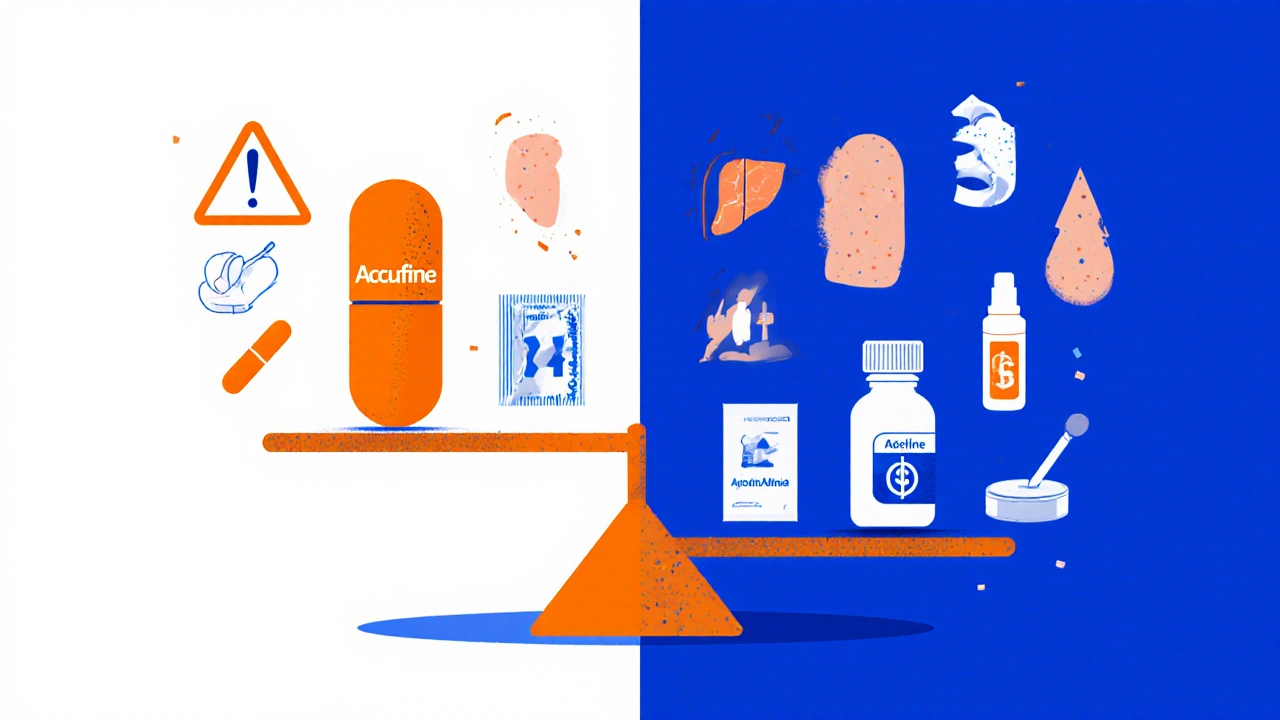
Cost and accessibility snapshot
Pricing can swing widely depending on insurance coverage and pharmacy. Below is an approximate cost range for a typical 30‑day supply in New Zealand dollars (NZD).
| Treatment | Typical Use | Efficacy (Severe Acne) | Common Side Effects | Approx. Monthly Cost (NZD) |
|---|---|---|---|---|
| Accufine (Isotretinoin) | Oral, 0.5‑1mg/kg daily for 4‑6months | 70‑90% lesion clearance | Dryness, liver enzyme rise, teratogenic | ≈350‑500 (specialty pharmacy) |
| Doxycycline | Oral, 100mg BID for 3‑4months | 30‑50% improvement | Sun sensitivity, GI upset | ≈20‑30 |
| Minocycline | Oral, 50‑100mg daily | 30‑55% improvement | Skin discoloration (rare), vestibular issues | ≈25‑35 |
| Adapalene (0.1% gel) | Topical, once daily | 15‑30% improvement | Dryness, mild irritation | ≈15‑25 |
| Tretinoin (0.05‑0.1% cream) | Topical, once nightly | 20‑40% improvement | Redness, peeling | ≈30‑45 |
| Oral contraceptives | Daily, 21‑day cycle | 20‑35% improvement (female patients) | Nausea, breast tenderness | ≈10‑15 |
| Spironolactone | Oral, 50‑200mg daily | 25‑45% improvement (female patients) | Dizziness, potassium rise | ≈12‑20 |
| Trifarotene (oral) | Oral, 10mg daily for 4‑5months | 60‑80% lesion clearance (early data) | Dryness, mild liver changes | ≈300‑400 |
Choosing the right option: decision guide
There’s no one‑size‑fits‑all answer. Below is a practical framework to help you narrow the field.
- Severity matters. If you have nodular cysts that scar easily, Accufine or Trifarotene are the only treatments that reliably clear the skin fast enough to prevent permanent marks.
- Pregnancy potential. Women who are or could become pregnant should stay away from oral retinoids. Hormonal therapy or spironolactone become the first line.
- Tolerance to side effects. If you’ve struggled with dry skin or liver issues, a low‑dose doxycycline combined with a topical retinoid may be gentler.
- Insurance and budget. Public health schemes in New Zealand often cover antibiotics and hormonal pills but not high‑cost retinoids. Check your subsidy options before committing.
- Long‑term maintenance. Even after a successful Accufine course, many dermatologists recommend a gentle topical retinoid to keep breakouts at bay.
Discuss these points with a dermatologist. They can run baseline labs, confirm pregnancy status, and tailor the dose to your weight and skin response.
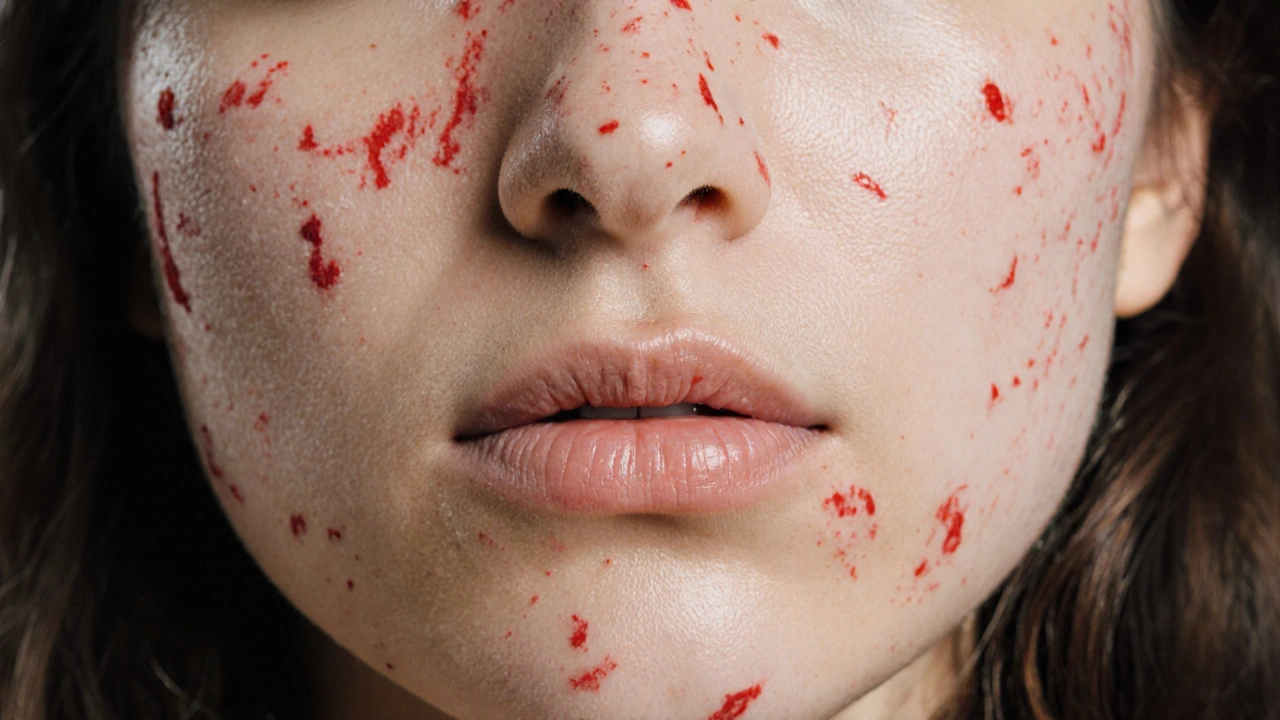
Quick reference table
For fast comparison, here’s a cheat‑sheet you can print or screenshot.
| Treatment | Best for | Main drawback | Typical duration |
|---|---|---|---|
| Accufine (Isotretinoin) | Severe nodular/cystic acne | Teratogenic, liver monitoring | 4‑6months |
| Doxycycline | Inflammatory papules/pustules | Sun sensitivity | 3‑4months |
| Adapalene | Mild‑moderate acne, maintenance | Dryness | Ongoing |
| Oral contraceptives | Hormonal acne in women | Potential clot risk | Ongoing |
| Spironolactone | Hormonal acne, adult women | Potassium monitoring | Ongoing |
| Trifarotene | Severe acne, retinoid‑savvy patients | Still requires monitoring | 4‑5months |
Frequently Asked Questions
Can I take Accufine while on birth control?
Yes, using two reliable forms of contraception (e.g., hormonal pill + condom) is mandatory while on Accufine and for at least one month after stopping. Birth control alone does not replace the need for strict contraception because isotretinoin is highly teratogenic.
Is the acne flare‑up after starting Accufine normal?
A short‑term worsening, called “purging,” is common during the first 4‑6 weeks. It happens because the drug speeds up cell turnover, pushing clogged pores to the surface faster. Most dermatologists recommend continuing the regimen unless the flare becomes severe.
How do I know if my liver labs are safe on Accufine?
Baseline liver enzymes are measured before the first dose, then repeated at 4‑week intervals. If ALT or AST rise above three times the upper limit of normal, the dermatologist will usually pause the medication until levels normalize.
Are there any over‑the‑counter options that work as well as Accufine?
No over‑the‑counter product matches the dramatic clearance rate of isotretinoin for severe acne. OTC retinoids like adapalene help with mild to moderate cases but rarely achieve the 70‑90% reduction that Accufine delivers in cystic acne.
What is the biggest reason patients stop Accufine early?
Intolerable dryness and cheilitis are the most common complaints. Proper moisturising regimes and lip balms can mitigate these, but some patients still discontinue because the side effects outweigh the benefit.
How does Trifarotene differ from traditional isotretinoin?
Trifarotene selectively activates retinoic acid receptor‑γ, which is abundant in skin but less present in liver. Early trials suggest a slightly lower incidence of severe mucosal dryness, but monitoring is still required.
Write a comment
Your email address will not be published.
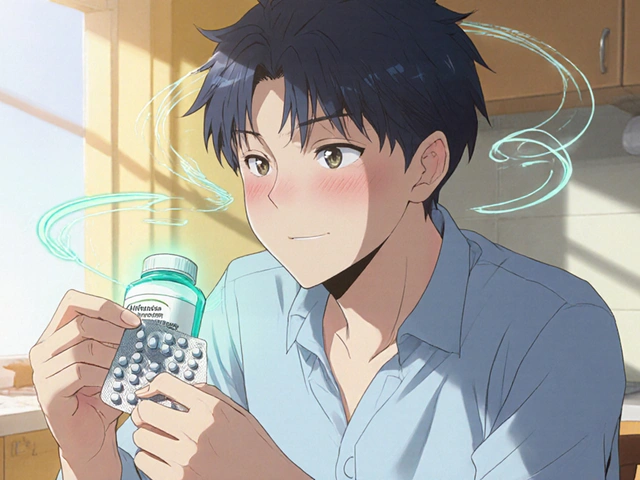
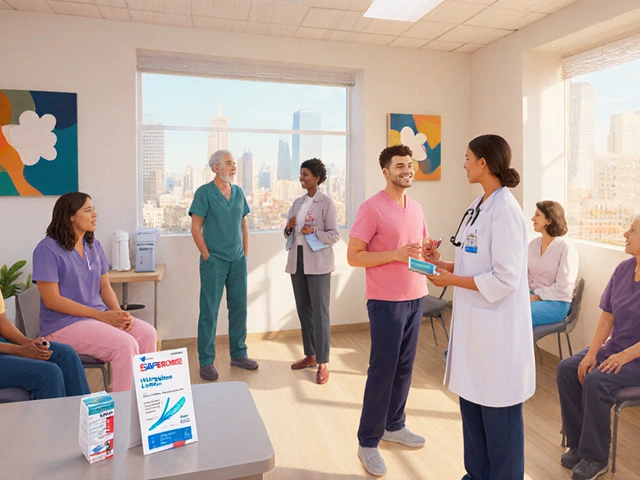


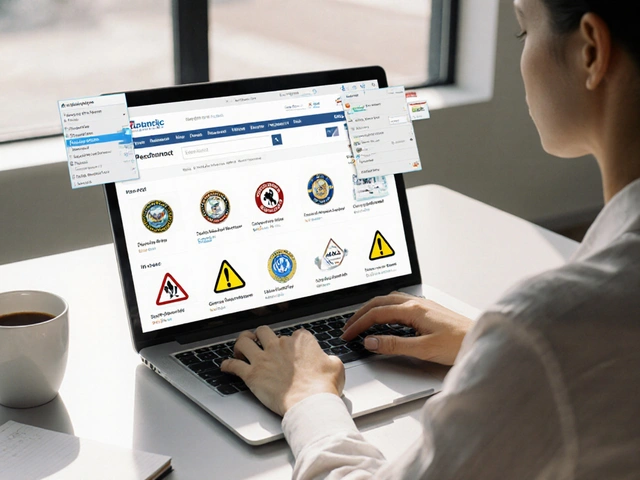
12 Comments
Yo, you think Accufine is the miracle drug? 😂 It’ll dry you out like a desert, good luck with that.
If you’re on the fence, remember that consistency beats hype. Stick to a plan and the skin will thank you!
The article correctly notes that isotretinoin requires monitoring, but it omits the recommended baseline fasting lipid panel, which is essential for detecting hypertriglyceridemia early.
Hang in there, folks! 🌟 Even the toughest acne can calm down with the right combo of meds and gentle skincare. You’ve got this!
Isotretinoin feels like the philosopher’s stone of dermatology – it promises transformation but asks for a sacrifice of comfort. 🌱 The dryness and lab work can feel like a rite of passage, yet the payoff of clear skin often justifies the ordeal. Remember, every scar you erase is a story rewritten.
Accufine works best for severe nodular acne, but you need regular blood tests. If liver enzymes rise, the doctor will pause the treatment.
Picture this: you start doxycycline, and within weeks the inflamed papules shrink like ice melting under a summer sun. It’s not magic, just a solid anti‑inflammatory at work, and you can pair it with a gentle retinoid for maintenance. The combo keeps breakouts in check while you avoid the harsher side effects of isotretinoin.
Don’t forget to moisturize! A good barrier cream can keep that Accufine‑induced dryness manageable 😊. Also, a lip balm with ceramides makes the cheilitis less painful.
Honestly, the hype around Accufine often eclipses the mundane reality of daily blood work and relentless dryness. While the clearance rates look impressive on paper, many patients quit early because the side‑effects are a daily battle. Doxycycline may not promise 90% clearance, but its side‑effect profile is far more tolerable for most. If you’re not pregnant, weigh the risk–benefit matrix rather than chasing the quickest fix. Bottom line: no one‑size‑fits‑all, and the decision should be guided by personal health priorities.
TL;DR: Accufine’s ROI is questionable when you factor in hepatic stewardship costs.
Whoa, that’s a bold take! 🎭 While the cost‑benefit angle matters, many of us have lived the pain of severe cystic acne for years, and the prospect of a 70‑90% clearance can be life‑changing. Sure, liver monitoring adds a step, but the confidence boost after clearing those nasty nodules is priceless. Let’s not dismiss the emotional toll of fighting breakout after breakout.
Whilst the presented data is comprehensive, one must question the comparative methodology employed. The authors appear to equate efficacy percentages without accounting for patient‑specific variables such as hormonal status or comorbidities. Moreover, the cost analysis lacks a sensitivity assessment for insurance variability. Consequently, the recommendation may inadvertently bias clinicians toward isotretinoin irrespective of individualized risk profiles.